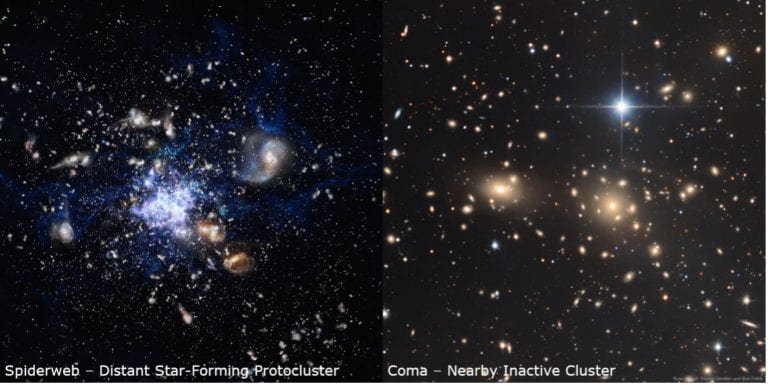UCI, UC Riverside astronomers discover galactic protocluster in early universe

In the early universe, all previously discovered distant protoclusters – such as the Spiderweb (artist’s impression at left) – are full of vigorously star-forming galaxies. In contrast, the newly detected protocluster MAGAZ3NE J095924+022537 contains numerous red and dead galaxies, similar to the nearby Coma cluster (right). The discovery of an ancient cluster of galaxies resembling those found in modern clusters was a huge surprise to the team of researchers from UCI, UC Riverside and other institutions.
Irvine, Calif., Feb. 10, 2022 – An international team of astronomers, including researchers from the University of California, Irvine and UC Riverside, has discovered a massive cluster of young galaxies forming in the early universe. The growing cosmic metropolis, named MAGAZ3NE J095924+022537, is a massive newborn galaxy cluster, or protocluster, consisting of at least 38 members and is about 11.8 billion light-years away from Earth.
Galaxy clusters get larger over time under gravity and, in the present-day universe, can contain hundreds or even thousands of galaxies, as well as hot gas and dark matter. Eventually, their galaxies burn through the fuel available and evolve from prolific star-producing galaxies into red and dead galaxies.
“In the early universe, all protoclusters discovered until now are full of vigorously star-forming galaxies,” said Ian McConachie, a graduate student in the UC Riverside Department of Physics & Astronomy and lead author of a research paper on the detection published in The Astrophysical Journal. “But incredibly, unlike all of the other protoclusters which have been found at this epoch, many galaxies in MAGAZ3NE J0959 appear to have already stopped forming stars.”
Co-author Mike Cooper, UCI professor of physics & astronomy, said that J0959 was discovered as part of an ongoing survey designed to find and study the early universe’s most massive galaxies.
“These observations offer a unique opportunity to study how the most massive structures in our universe formed,” he said. “We are seeing this protocluster as it appeared when the universe was less than 2 billion years old.”
Co-author Benjamin Forrest, a postdoctoral scholar formerly at UC Riverside now at UC Davis, explained that at the heart of MAGAZ3NE J0959 is a galaxy containing a mass of more than 200 billion suns.
“Why this ultramassive galaxy and so many of its neighbors formed most of their stars and then became inactive when the universe was still so young, in contrast to other known protoclusters from the same time, is a big mystery,” he said.
Forrest noted that MAGAZ3NE J0959 was discovered from the ground. The advent of powerful new capabilities, such as the recently launched James Webb Space Telescope, should soon reveal whether there are other protoclusters like MAGAZ3NE J0959 packed with dead galaxies waiting to be found in the early universe. Should such protoclusters be detected in large numbers, the current paradigm of protocluster formation would require a major revision. A new concept of protoclusters existing in a diversity of states in the early universe would have to be adopted. With many member galaxies quenching – a process by which they lose cold gas and produce fewer stars – in the first 2 billion years, a new model of protocluster evolution would almost certainly pose significant challenges for current models of galaxy formation.
The team used observations from the W.M. Keck Observatory’s Multi-Object Spectrograph for Infrared Exploration to make detailed measurements of MAGAZ3NE J0959 and precisely quantify its distance.
Closely associated with the question of how ultramassive galaxies form is the question of the environment in which they form, e.g., are they always found in extremely dense regions like protoclusters, or can they also form in isolation? Next, the team plans a comprehensive study of the other ultramassive galaxies in the MAGAZ3NE survey to try to answer this question.
Other researchers involved in the project were Cemile Marsan and Adam Muzzin of Canada’s York University; Gillian Wilson, Jeffrey Chan and Mohamed Abdullah of UC Riverside; Marianna Annunziatella and Danilo Marchesini of Tufts University; Percy Gomez of Hawaii’s W.M. Keck Observatory; Paolo Saracco of the Astronomical Observatory of Brera, Italy; and Julie Nantais of Chile’s Andrés Bello National University.
The study was supported by grants from the National Science Foundation and NASA.
About the University of California, Irvine: Founded in 1965, UCI is the youngest member of the prestigious Association of American Universities and is ranked among the nation’s top 10 public universities by U.S. News & World Report. The campus has produced five Nobel laureates and is known for its academic achievement, premier research, innovation and anteater mascot. Led by Chancellor Howard Gillman, UCI has more than 36,000 students and offers 224 degree programs. It’s located in one of the world’s safest and most economically vibrant communities and is Orange County’s largest employer, contributing $7 billion annually to the local economy and $8 billion statewide. For more on UCI, visit www.uci.edu.
Media access: Radio programs/stations may, for a fee, use an on-campus ISDN line to interview UCI faculty and experts, subject to availability and university approval. For more UCI news, visit news.uci.edu. Additional resources for journalists may be found at communications.uci.edu/for-journalists.
About UCI’s Brilliant Future campaign: Publicly launched on Oct. 4, 2019, the Brilliant Future campaign aims to raise awareness and support for UCI. By engaging 75,000 alumni and garnering $2 billion in philanthropic investment, UCI seeks to reach new heights of excellence in student success, health and wellness, research and more. The School of Physical Sciences plays a vital role in the success of the campaign. Learn more by visiting https://brilliantfuture.uci.edu/uci-school-of-physical-sciences/.
